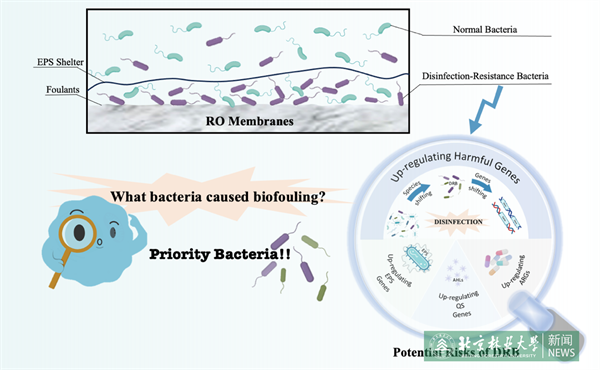Recently, a research paper titled "Priority Bacteria Causing Biofouling of Reverse Osmosis Membranes: Potential Disinfection-Resistant Bacteria and Control Strategies", conducted by a research team from the College of Environmental Science and Engineering, was published in the top-tier environmental journal Desalination (IF=9.9). This study was a collaboration between Professor Hong Yu's team from Beijing Forestry University and Professor Hu Hongying's team from Tsinghua University. The paper's first author is Gao Yujia, a PhD student from the College of Environmental Science and Engineering. Professor Hong Yu and Associate Researcher Wu Yinhai from Tsinghua University are the co-corresponding authors. Beijing Forestry University is the signature unit of the first author.

What bacteria cause membrane biofouling in engineering practice? This is the fundamental question in the research on biofouling, which is the Achilles' heel of the reverse osmosis (RO) system. If this question is not addressed clearly, the subsequent research on mechanism interpretation and possible control technologies is questionable due to the lack of appropriate research objects. However, a uniform conclusion has not yet been given, as it varied considerably in different studies. Here, to better cope with RO membrane biofouling introduced by microbiomes, 46 genera of residual microorganisms that tend to adhere to the surface of RO membranes were summarized. Interestingly, disinfection-resistant bacteria (DRB) accounted for 75% of those reported with high and medium frequency. From the perspective of frequency of occurrence, phylogenetic relationship, and co-occurrence network analysis of membrane-attached residual microorganisms, the fundamental characteristics were identified to recognize the priority bacteria in common. Further, a series of undesirable risks posed by DRB on the level of harmful genes transfer were highlighted. Correspondingly, feasible control strategies to effectively alleviate biofouling and their application in RO systems were discussed. This work identified priority species and their detrimental effects on RO membrane biofouling and provided new insights to solve the inevitable issue.
This work was financially supported by the Major Program of National Natural Science Foundation of China (No. 52293440, No. 52293442) and Science Fund for Creative Research Groups (No. 52221004).
Paper link: https://doi.org/10.1016/j.desal.2024.117484
Written by Gao Yujia
Translated and edited by Song He
Reviewed by Yu Yangyang













